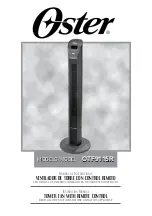
10
Figure 20
Figure 21
13. OPERATING
INSTRUCTIONS
Restore power to ceiling fan and test for
proper operation.
A. HI, MED, and LOW buttons:
These three buttons are used to set
the fan speed as follows:
HI= high speed
Med= medium speed
Low= low speed
B. OFF button:
This button turns the fan off.
C. button:
This button controls the light. Press
and release the button to turn the
light ON or OFF. Press and hold the
button to set the desired brightness.
The light key has an auto-resume, it
will stay at the same brightness as
the last time it was turned off.
D. The "REV" button is used to set the fan
forward or reverse, press the button
forward (for warm weather) or reverse
(for cool weather).
12. INSTALLING THE
BATTERY
Install 9 volt battery (included), to prevent
damage to transmitter, remove the
battery if not used for long periods. (Fig.
20)
9 Volt Battery
LOW
OFF
HI
MED
REV






























